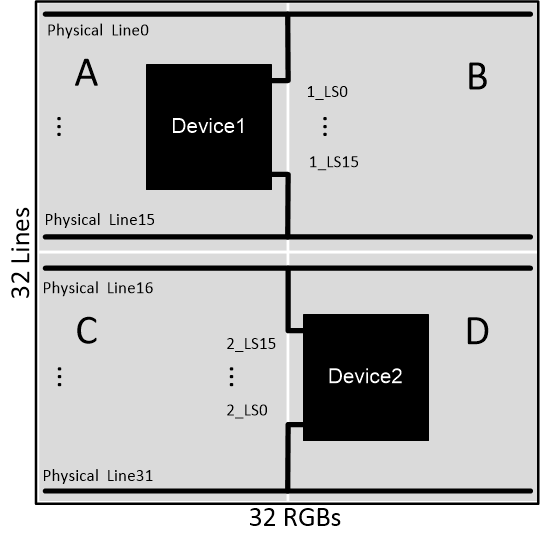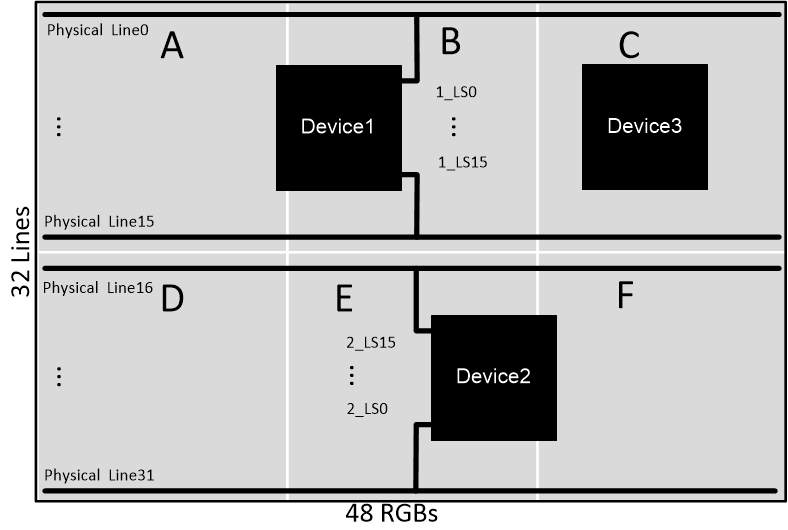SLVSGD5 July 2021 LP5890
PRODUCTION DATA
- 1 Features
- 2 Applications
- 3 Description
- 4 Revision History
- 5 Description (continued)
- 6 Pin Configuration and Functions
- 7 Specifications
-
8 Detailed Description
- 8.1 Overview
- 8.2 Functional Block Diagram
- 8.3
Feature Description
- 8.3.1 Independent and Stackable Mode
- 8.3.2 Current Setting
- 8.3.3 Frequency Multiplier
- 8.3.4 Line Transitioning Sequence
- 8.3.5 Protections and Diagnostics
- 8.4 Device Functional Modes
- 8.5 Continuous Clock Series Interface
- 8.6 PWM Grayscale Control
- 8.7 Register Maps
- 9 Application and Implementation
- 10Power Supply Recommendations
- 11Layout
- 12Device and Documentation Support
- 13Mechanical, Packaging, and Orderable Information
Package Options
Mechanical Data (Package|Pins)
Thermal pad, mechanical data (Package|Pins)
Orderable Information
8.3.1.2 Stackable Mode
While operating the LP5890 in stackable mode, as shown in Figure 8-2 and Figure 8-3, Device2 needs to be rotated 180o relative to Device1. This action allows the position of line switches to be near the center column of the LED matrix for better routing. For Device1, the lines will be connected sequentially (line switch 0 connected to scan line 1). However, on Device2, it is connected in reverse order, with the 16th scan line is connected to line switch 15 and the 32th scan line is connected to line switch 0.
Figure 8-2 shows the connection between two LP5890 devices in stackable mode driving a 32 × 32 RGB LED pixels. The MOD_SIZE should be configured to 00b/10b. Device1 supplies 16 line switches for the first 16 scan line, and Device2 supplies 16 line switches for scan line 17-32. The data for matrix sections A and C are stored in Deivce1, while matrix sections B and D data are stored in Device2.
 Figure 8-2 Two Devices in Stackable Mode
Figure 8-2 Two Devices in Stackable ModeFigure 8-3 shows the connection between three devices connected in stackable mode with MOD_SIZE bits set to 11b. In this configuration, Device1 supplies the line switches for the first 16 scan lines, Device2 supplies line switches for scan lines 17-32, and the line switches of Device3 are not used. Matrix A and D's data are stored in Device 1, matrix B and E's data are stored in Device2, and matrix C and F's data are stored in Device3.
 Figure 8-3 Three Devices in Stackable
Mode
Figure 8-3 Three Devices in Stackable
ModeIn order to make sure the scanning sequence is still from 1st line to 32nd line, the scan line switching order of the second device needs to be reversed. This action can be configured by the SCAN_REV (For more details, see FC4).
Table 8-1 shows the pin assignment between the LED matrix physical lines and the LP5890 corresponding pins, depending on the SCAN_REV.
| LED Matrix Physical Line | Device Line Switch Pin (SCAN_REV = 1) | Device Line Switch Pin (SCAN_REV = 0) |
|---|---|---|
| L0 | 1_LS0 | 1_LS0 |
| L1 | 1_LS1 | 1_LS1 |
| L2 | 1_LS2 | 1_LS2 |
| L3 | 1_LS3 | 1_LS3 |
| L4 | 1_LS4 | 1_LS4 |
| L5 | 1_LS5 | 1_LS5 |
| L6 | 1_LS6 | 1_LS6 |
| L7 | 1_LS7 | 1_LS7 |
| L8 | 1_LS8 | 1_LS8 |
| L9 | 1_LS9 | 1_LS9 |
| L10 | 1_LS10 | 1_LS10 |
| L11 | 1_LS11 | 1_LS11 |
| L12 | 1_LS12 | 1_LS12 |
| L13 | 1_LS13 | 1_LS13 |
| L14 | 1_LS14 | 1_LS14 |
| L15 | 1_LS15 | 1_LS15 |
| L16 | 2_LS15 | 2_LS0 |
| L17 | 2_LS14 | 2_LS1 |
| L18 | 2_LS13 | 2_LS2 |
| L19 | 2_LS12 | 2_LS3 |
| L20 | 2_LS11 | 2_LS4 |
| L21 | 2_LS10 | 2_LS5 |
| L22 | 2_LS9 | 2_LS6 |
| L23 | 2_LS8 | 2_LS7 |
| L24 | 2_LS7 | 2_LS8 |
| L25 | 2_LS6 | 2_LS9 |
| L26 | 2_LS5 | 2_LS10 |
| L27 | 2_LS4 | 2_LS11 |
| L28 | 2_LS3 | 2_LS12 |
| L29 | 2_LS2 | 2_LS13 |
| L30 | 2_LS1 | 2_LS14 |
| L31 | 2_LS0 | 2_LS15 |
When the LP5890 devices are used in stackable mode, if there are unused line switches, these unused line switches must be the last line switches of the first or the second device. For example, if there are only 30 scanning lines, and if,
The unused line switches must be 2_LS14, 2_LS15 if SCAN_REV = '0'b, or 2_LS1, 2_LS0 if SCAN_REV = '1'b.